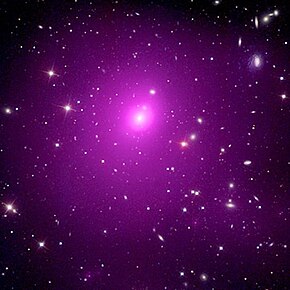| Holmberg 15A | |
|---|---|
 Holmberg 15A (in the center) in X-rays by Chandra X-ray Observatory Holmberg 15A (in the center) in X-rays by Chandra X-ray Observatory | |
| Observation data (J2000.0 epoch) | |
| Constellation | Cetus |
| Right ascension | 00 41 50.5 |
| Declination | −09° 18′ 11″ |
| Redshift | 0.055672 |
| Heliocentric radial velocity | 16690 km/s |
| Galactocentric velocity | 16747 km/s |
| Distance | 704×10 h 0.678 |
| Group or cluster | Abell 85 (cluster)Abell 85 |
| Apparent magnitude (V) | 14.7 |
| Characteristics | |
| Type | cD;BrClG |
| Mass | 7×10 M☉ |
| Number of stars | 5×10 |
| Size | 270,000 ly (83 kpc) |
| Apparent size (V) | 1.3 moa |
| Other designations | |
| Abell 85-BCG, PGC 2501 | |
Holmberg 15A (abbreviated to Holm 15A) is a supergiant elliptical galaxy and the central dominant galaxy of the Abell 85 galaxy cluster in the constellation Cetus, about 700 million light-years from Earth. It was discovered c. 1937 by Erik Holmberg. It became well known when it was reported to have the largest core ever observed in a galaxy, spanning some 15,000 light years, however this was subsequently refuted.
Supermassive black hole
It has been postulated that the primary component of the galactic core is a supermassive black hole with a mass of 40 billion solar masses (M☉), although no direct measurement has yet been made. Previous estimates by Lauer et al. have jointed a mass value as high as 310 billion M☉ using the gamma ray point break radius method. Kormendy and Bender gave a value of 260 billion M☉ in a 2009 paper. Lower estimates were given by Kormendy and Ho et al. in 2013 at 2.1 and 9.2 billion M☉. The paper by Lopez-Cruz et al. stated: "Therefore, we conservatively suggest that Holm 15A hosts an SMBH with a mass of ~1×10 M☉." Kormendy and Ho et al derived these equations using the M–sigma relation and the size of the outer bulge of the galaxy, which are indirect estimates. Rusli et al derived a value of 170 billion M☉ using break radius methodology. In addition, Abell 85 has its velocity dispersion of dark matter halo at ~750 km/s, which could be explained only by a black hole with a mass greater than 150 billion M☉, although Kormendy and Ho et al stated that "dark matter halos are scale-free, and the SMBH-dark matter coevolution is independent from the effects of baryons". This makes it one of the most massive black holes ever discovered, with it being classified as an ultramassive black hole.
See also
References
- ^ "Astronomers Just Found an Absolutely Gargantuan Black Hole The Mass of 40 Billion Suns". 6 August 2019.
- ^ López-Cruz, O.; Añorve, C.; Birkinshaw, M.; Worrall, D. M.; Ibarra-Medel, H. J.; Barkhouse, W. A.; Torres-Papaqui, J. P.; Motta, V. (2014). "The Brightest Cluster Galaxy in Abell 85: The Largest Core Known So Far". The Astrophysical Journal. 795 (2): L31. arXiv:1405.7758. Bibcode:2014ApJ...795L..31L. doi:10.1088/2041-8205/795/2/L31. S2CID 1140857.
- Bonfini, Paolo; Dullo, Bililign T.; Graham, Alister W. (2015), Too Big to Be Real? No Depleted Core in Holm 15A
- Madrid, Juan P.; Donzelli, Carlos J. (2016), The Abell 85 BCG: A Nucleated, Coreless Galaxy
- Tangermann, Victor (August 6, 2019). "Astronomers Just Discovered One Of The Biggest Black Holes Ever". Futurism.com. Retrieved August 7, 2019.
- K. Mehrgan; J. Thomas; R. Saglia; X. Mazzalay; P. Erwin; R. Bender; M. Kluge; M. Fabricius (24 July 2019). "A 40 Billion Solar-mass Black Hole in the Extreme Core of Holm 15A, the Central Galaxy of Abell 85". The Astrophysical Journal. 887 (2): 195. arXiv:1907.10608. Bibcode:2019ApJ...887..195M. doi:10.3847/1538-4357/ab5856. S2CID 198899965. Measures SMBH mass as (40±8)×10 M☉.
This elliptical galaxy article is a stub. You can help Misplaced Pages by expanding it. |